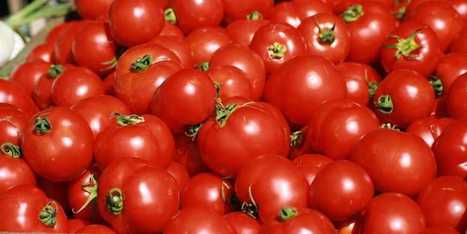 Your new post is loading...
 Your new post is loading...

|
Scooped by
Ed Rybicki
July 3, 2020 4:29 AM
|
Plant gene editing is typically performed by delivering reagents such as Cas9 and single guide RNAs to explants in culture. Edited cells are then induced to differentiate into whole plants by exposure to various hormones. The creation of edited plants through tissue culture is often inefficient, tim …

|
Scooped by
Ed Rybicki
June 17, 2020 9:23 AM
|
Moms Across America - From Seed to Supermarket We're Forging a New Standard for a Healthy Planet...

|
Scooped by
Ed Rybicki
June 15, 2020 5:54 AM
|
An effective prophylactic vaccine is urgently needed to protect against SARS-CoV-2 infection. The viral spike, which mediates entry into cells by interacting with the host angiotensin-converting enzyme 2, is the primary target of most vaccines in development. These vaccines aim to elicit protective immunity against the glycoprotein by use of inactivated virus, vector-mediated delivery of the antigen in vivo, or by direct immunization with the purified antigen following expression in a heterologous system. These approaches are mostly dependent on the growth of mammalian or insect cells, which requires a sophisticated infrastructure that is not generally available in developing countries due to the incumbent costs which are prohibitive. Plant-based subunit vaccine production has long been considered as a cheaper alternative, although low expression yields and differences along the secretory pathway to mammalian cells have posed a challenge to producing certain viral glycoproteins. Recent advances that have enabled many of these constraints to be addressed include expressing the requisite human proteins in plants to support the maturation of the protein of interest. In this study we investigated these approaches to support the production of a soluble and putatively trimeric SARS-CoV-2 spike mimetic in Nicotiana benthamiana via transient Agrobacterium-mediated expression. The co-expression of human calreticulin dramatically improved the accumulation of the viral spike, which was barely detectable in the absence of the co-expressed accessory protein. The viral antigen was efficiently processed even in the absence of co-expressed furin, suggesting that processing may have occurred at the secondary cleavage site and was mediated by an endogenous plant protease. In contrast, the spike was not efficiently processed when expressed in mammalian cells as a control, although the co-expression of furin improved processing considerably. This study demonstrates the feasibility of molecular engineering to improve the production of viral glycoproteins in plants, and supports plant-based production of SARS-CoV-2 spike-based vaccines and reagents for serological assays.

|
Rescooped by
Ed Rybicki
from Virology News
June 15, 2020 5:52 AM
|
While large companies and public sector consortiums in the United States, Canada, China and Europe are running at full speed to develop a vaccine grown in genetically modified (GM) tobacco plants, a research group at a Mexican university is working toward the same objective, but with a different and innovative strategy. They are using bioinformatics …

|
Scooped by
Ed Rybicki
May 28, 2020 7:49 AM
|
The Tier 1 select agent Burkholderia pseudomallei is the causative agent of melioidosis, a global pathogen and a major cause of pneumonia and sepsis for which no licensed vaccines currently exist. Previous work has shown the potential for Burkholderia capsular polysaccharide (CPS) to be used as a vaccine antigen but the T-cell independent nature of the immune response to this molecule requires the use of this polysaccharide as a glycoconjugate for vaccination. Recent studies have focussed on the use of Crm197 (a non-toxic mutant protein derived from diphtheria toxin) as the carrier but there are concerns regarding its potential to cause interference with other vaccines containing Crm197. Therefore research with alternative carrier proteins would be beneficial. In this study, CPS was isolated from the non-pathogenic B. thailandensis strain E555. This was chemically conjugated to Crm197, or Tandem Core™ virus-like particles (TCVLP) consisting of hepatitis B core protein, which is the first documented use of VLPs in melioidosis vaccine development. Analysis of CPS-specific IgG antibody titres showed that mice vaccinated with the Crm197 conjugate generated significantly higher titres than the mice that received TCVLP-CPS but both conjugate vaccines were able to protect mice against intraperitoneal B. pseudomallei strain K96243 challenges of multiple median lethal doses.

|
Scooped by
Ed Rybicki
May 27, 2020 6:03 AM
|
Medicago, Inc. (Quebec City, Canada), a biopharmaceutical company, has successfully produced a Virus-Like Particle (VLP) of the coronavirus just 20 days after obtaining the SARS-CoV-2 (virus causing the COVID-19 disease) gene. The production of the VLP is the first step in developing a vaccine for COVID-19 which will now undergo preclinical testing for safety and efficacy. Once this is completed, Medicago expects to discuss with the appropriate health agencies to initiate human trials of the vaccine by July-August 2020.

|
Scooped by
Ed Rybicki
May 27, 2020 5:56 AM
|
We describe the antiviral activity of plant lectins with specificity for different glycan structures against the severe acute respiratory syndrome coronavirus (SARS-CoV) and the feline infectious peritonitis virus (FIPV) in vitro. The SARS-CoV emerged in 2002 as an important cause of severe lower respiratory tract infection in humans, and FIPV infection causes a chronic and often fatal peritonitis in cats. A unique collection of 33 plant lectins with different specificities were evaluated. The plant lectins possessed marked antiviral properties against both coronaviruses with EC50 values in the lower microgram/ml range (middle nanomolar range), being non-toxic (CC50) at 50–100 μg/ml. The strongest anti-coronavirus activity was found predominantly among the mannose-binding lectins. In addition, a number of galactose-, N-acetylgalactosamine-, glucose-, and N-acetylglucosamine-specific plant agglutinines exhibited anti-coronaviral activity. A significant correlation (with an r-value of 0.70) between the EC50 values of the 10 mannose-specific plant lectins effective against the two coronaviruses was found. In contrast, little correlation was seen between the activity of other types of lectins. Two targets of possible antiviral intervention were identified in the replication cycle of SARS-CoV. The first target is located early in the replication cycle, most probably viral attachment, and the second target is located at the end of the infectious virus cycle.

|
Scooped by
Ed Rybicki
May 27, 2020 5:47 AM
|
Protein expression production services | Experts in expression and the production of proteins, including antibodies and allergens, enzymes and vaccines. %

|
Scooped by
Ed Rybicki
May 27, 2020 5:24 AM
|
Medicago, Inc. (Quebec City, Canada), a biopharmaceutical company, has successfully produced a Virus-Like Particle (VLP) of the coronavirus just 20 days after obtaining the SARS-CoV-2 (virus causing the COVID-19 disease) gene. The production of the VLP is the first step in developing a vaccine for COVID-19 which will now undergo preclinical testing for safety and efficacy. Once this is completed, Medicago expects to discuss with the appropriate health agencies to initiate human trials of the vaccine by July-August 2020.

|
Scooped by
Ed Rybicki
May 26, 2020 6:46 AM
|
Genome editing via the homology‐directed repair (HDR) pathway in somatic plant cells is very inefficient compared with error‐prone repair by nonhomologous end joining (NHEJ). Here, we increase

|
Scooped by
Ed Rybicki
May 26, 2020 6:43 AM
|
Over the last three decades, the development of new genome editing techniques, such as ODM, TALENs, ZFNs and the CRISPR‐Cas system, has led to significant progress in the field of plant and anima

|
Scooped by
Ed Rybicki
May 26, 2020 6:35 AM
|
CRISPR/Cas9 systems have been widely used in functional genomics and crop genetic improvement, but the protospacer adjacent motif (PAM) sequence NGG of Streptococcus pyogenes Cas9 (SpCas9) limits its targeting scope. To expand the targetable genomic loci, several other Cas proteins and Cas9 variants with different PAM specificities have been developed (Li et al. , 2019), such as Cpf1 (Cas12a) with T‐rich PAM, and SpCas9 VQR and VRER variants with non‐canonical NGA and NGCA PAM sequence, respectively. Recently, two engineered SpCas9 variants, xCas9 3.7 and Cas9‐NG, expand the PAM recognition site to NG and show function efficiency in mammalian cells (Hu et al. , 2018; Nishimasu et al. , 2018). Although a few tests of the two variants have been reported in plants (Ge et al. , 2019; Li et al. , 2019), there are still not enough comparative data on their efficiencies on genome and base editing in plants. Furthermore, to reduce the possible off‐target effects, it is necessary to develop a new Cas9 variant with both enhanced specificity (eCas9) and altered PAM site such as NG. The eCas9 variant has neutralization of positive charges in the nt‐groove that can remarkably decrease off‐target (Slaymaker et al. , 2016). In this study, we developed a serial of variants including a new eCas9‐NG and investigated the editing activities of those variants (xCas9, Cas9‐NG and eCas9‐NG) with expended target scope in genome editing, cytosine base editors including CBE4, xCas9n‐CBE, Cas9n‐NG‐CBE and eCas9n‐NG‐CBE, adenine base editors including ABE7.10, xCas9n‐ABE, Cas9n‐NG‐ABE and eCas9n‐NG‐ABE in transgenic rice.

|
Scooped by
Ed Rybicki
January 15, 2020 3:41 AM
|
Talk about a high profile discovery...
|

|
Scooped by
Ed Rybicki
June 17, 2020 9:24 AM
|
VICTORIA, British Columbia, June 17, 2020 (GLOBE NEWSWIRE) -- Pressure grows on Health Minister, Patty Hajdu, as palliative Canadians wait for the health...

|
Scooped by
Ed Rybicki
June 17, 2020 9:22 AM
|

|
Rescooped by
Ed Rybicki
from Virology News
June 15, 2020 5:53 AM
|
The rush to develop a vaccine for COVID-19 has extended to Italy and Israel, where scientists are using the tools of genetic engineering to develop algae-based edible vaccines against the disease caused by the novel coronavirus.

|
Scooped by
Ed Rybicki
May 28, 2020 10:45 AM
|
Plant molecular farming (PMF) is a convenient and cost-effective way to produce high-value recombinant proteins that can be used in the production of a range of health products, from pharmaceutical therapeutics to cosmetic products. New plant breeding techniques (NPBTs) provide a means to enhance PMF systems more quickly and with greater precision than ever before. However, the feasibility, regulatory standing and social acceptability of both PMF and NPBTs are in question. This paper explores the perceptions of key stakeholders on two European Union (EU) Horizon 2020 programmes–Pharma-Factory and Newcotiana–towards the barriers and facilitators of PMF and NPBTs in Europe. One-on-one qualitative interviews were undertaken with N = 20 individuals involved in one or both of the two projects at 16 institutions in seven countries (Belgium, France, Germany, Italy, Israel, Spain and the UK). The findings indicate that the current EU regulatory environment and the perception of the public towards biotechnology are seen as the main barriers to scaling-up PMF and NPBTs. Competition from existing systems and the lack of plant-specific regulations likewise present challenges for PMF developing beyond its current niche. However, respondents felt that the communication of the benefits and purpose of NPBT PMF could provide a platform for improving the social acceptance of genetic modification. The importance of the media in this process was highlighted. This article also uses the multi-level perspective to explore the ways in which NPBTs are being legitimated by interested parties and the systemic factors that have shaped and are continuing to shape the development of PMF in Europe.

|
Scooped by
Ed Rybicki
May 28, 2020 7:41 AM
|
Production of monomeric IgA in mammalian cells and plant expression systems such as Nicotiana benthamiana is well-established and can be achieved by co-expression of the corresponding light and heavy chains. In contrast, the assembly of dimeric IgA requires the additional expression of the joining chain and remains challenging especially in plant-based systems. Here, we examined factors affecting the assembly and expression of HER2 binding dimeric IgA1 and IgA2m(2) variants transiently produced in N. benthamiana. While co-expression of the joining chain resulted in efficient formation of dimeric IgAs in HEK293F cells, a mixture of monomeric, dimeric and tetrameric variants was detected in plants. Mass-spectrometric analysis of site-specific glycosylation revealed that the N-glycan profile differed between monomeric and dimeric IgAs in the plant expression system. Co-expression of a single-subunit oligosaccharyltransferase from the protozoan Leishmania major in N. benthamiana increased the N-glycosylation occupancy at the C-terminal heavy chain tailpiece and changed the ratio of monomeric to dimeric IgAs. Our data demonstrate that N-glycosylation engineering is a suitable strategy to promote the formation of dimeric IgA variants in plants.

|
Scooped by
Ed Rybicki
May 27, 2020 6:00 AM
|
The logo of an alliance of plant biotechnology companies making products derived from SARS-CoV-2. Global partners in the network include Canadian company Plantform and United Kingdom-based Leaf Expressions, both of whom will assist with scaling up production of the antigens to meet global demands. Academic partners include Plantvax (from the United States) and the Department of Applied Genetics and 3 Cell Biology (DAGZ) in the University of Natural Resources and Life Sciences, Vienna. They will be using the genetic constructs for their own research and development to further expand the community. Quebec-based vertical farming equipment design company, Inno-3B, aims to assist the Plants Against Corona initiative in rapidly scaling up their plantgrowth capacity.

|
Scooped by
Ed Rybicki
May 27, 2020 5:49 AM
|
Explore Cape Bio Pharms as commercial. If you are working for a commercial laboratory, let us help you design proteins fit for purpose.

|
Scooped by
Ed Rybicki
May 27, 2020 5:26 AM
|
The emergence of new pathogenic viral strains is a constant threat to global health, with the new coronavirus strain COVID-19 as the latest example. COVID-19, caused by the SARS-CoV-2 virus has quickly spread around the globe. This pandemic demands rapid development of drugs and vaccines. Plant-based vaccines are a technology with proven viability, which have led to promising results for candidates evaluated at the clinical level, meaning this technology could contribute towards the fight against COVID-19. Herein, a perspective in how plant-based vaccines can be developed against COVID-19 is presented. Injectable vaccines could be generated by using transient expression systems, which offer the highest protein yields and are already adopted at the industrial level to produce VLPs-vaccines and other biopharmaceuticals under GMPC-processes. Stably-transformed plants are another option, but this approach requires more time for the development of antigen-producing lines. Nonetheless, this approach offers the possibility of developing oral vaccines in which the plant cell could act as the antigen delivery agent. Therefore, this is the most attractive approach in terms of cost, easy delivery, and mucosal immunity induction. The development of multiepitope, rationally-designed vaccines is also discussed regarding the experience gained in expression of chimeric immunogenic proteins in plant systems.

|
Scooped by
Ed Rybicki
May 27, 2020 5:22 AM
|
This is the first evidence that replicating vectors can be successfully used for transient protein expression in BY-2 plant cell packs. Transient recombinant protein expression in plants and recently also plant cell cultures are of increasing interest due to the speed, safety and scalability of the process. Currently, studies are focussing on the design of plant virus-derived vectors to achieve higher amounts of transiently expressed proteins in these systems. Here we designed and tested replicating single and multi-cassette vectors that combine elements for enhanced replication and hypertranslation, and assessed their ability to express and particularly co-express proteins by Agrobacterium-mediated transient expression in tobacco BY-2 plant cell packs. Substantial yields of green and red fluorescent proteins of up to ~ 700 ng/g fresh mass were detected in the plant cells along with position-dependent expression. This is the first evidence of the ability of replicating vectors to transiently express proteins in BY-2 plant cell packs.

|
Scooped by
Ed Rybicki
May 26, 2020 6:45 AM
|
Geminiviruses are a family of plant viruses with circular single‐stranded DNA genomes. They have been deconstructed by researchers for multiple biotechnological applications, including protein expression, gene silencing and genome editing, in plants (Lozano‐Durán, 2016). Under the deconstructed virus strategy, the coat protein and movement protein genes were removed from the geminiviruses, while the sequences required for replication were retained. The replicons replicate after delivery to plant cells and increase the copy number of carried DNA; this leads to high levels of gene expression (Lozano‐Durán, 2016). Although a few geminiviral replicon‐based vectors have been used in gene targeting (Baltes et al. , 2014; Cermak et al. , 2015; Wang et al. , 2017), the list of DNA replicon‐based vectors is still limited in plants, especially for food crops. In this study, we developed sweet potato leaf curl virus (SPLCV) replicon‐based expression vectors. We tested the efficiency of these vectors in CRISPR‐Cas‐mediated RNA targeting and gene editing by using Nicotiana benthamiana as model plant.

|
Scooped by
Ed Rybicki
May 26, 2020 6:41 AM
|
Coriander (Coriandrum sativum L. 2n = 2x = 22), a plant from the Apiaceae family, also called cilantro or Chinese parsley, is a globally important crop used as vegetable, spice, fragrance an

|
Scooped by
Ed Rybicki
January 15, 2020 3:47 AM
|
Plant expression technologies may be used to produce inexpensive plant or animal virus proteins that self‐assemble into viral‐like nanoparticles or VNPs that can be used in nanotechnology or a
|

 Your new post is loading...
Your new post is loading...
 Your new post is loading...
Your new post is loading...





















